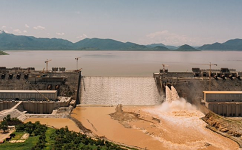The Prime Minister of Ethiopia Abiy Ahmed stresses the benefits of the controversial Grand Ethiopian Renaissance Dam (GERD) to the people of Ethiopia, Sudan and Egypt.
In his statement Abiy indicated that the major function of the GERD is “to manage the highly variable flow of the Abbay and produce 15,700-Gigawatt hour per year electricity since for Ethiopia electricity remains a resource that is enormously lacking.”
“Large quantity of the flow (about 90%) occurs within four months of the rainy season and during the rest of the year the mighty Abbay trickles like a small river. The dam is needed to regulate this variable flow by reducing flooding and augmenting dry flow,” he said.
“Ethiopia’s intention in constructing the GERD is to enable the regulation function so that electricity generation from the infrastructure is uniform throughout the year. This means, as a hydropower dam, the GERD does not consume water. Rather the water continues to flow downstream uninterrupted.”
“The benefits for downstream countries are often untold. In Sudan, for example, the GERD provides ample protection against devastating floods and the effects of water shortage during drought and dry periods. It will help Sudanese water infrastructure to be operated optimally as they receive regulated flow,” Abiy said.
“This means that more electricity could be generated from existing infrastructure and adequate and regular water could flow in the river downstream throughout the year to enable reliable water supply for people, agriculture, and the ecology. The GERD also brings more energy to the already interconnected systems of Sudan and Ethiopia as well as to others.”
“Egypt also benefits from water conservation at the GERD instead of wastage of billions of cubic meters of water to evaporation and in downstream flood plains. The GERD also helps to prevent future spillage that overtops the Aswan Dam,” Prime Minister Abiy stated in his statement in which he mentioned that electricity as “a basic infrastructure lacking in Ethiopia and over 53% of my fellow citizens or about 60 million people do not have access”.
Abiy also mentioned the fact that the large volume of the Nile water body, amounting to about 85%, originates from the highlands of Ethiopia. “As a transboundary resource, this water traverses through Ethiopia, Sudan and Egypt. The Ethiopia side comes from the tributaries of Abbay, Baro and Tekeze rivers while the other 15% of the Nile comes from other upstream Nile riparian countries. GERD is under construction near the border with the Sudan, where all tributaries of the Abbay join the main stem of the river. This consequently makes the location ideal to maximize electricity generation,” he said.
It has been reported that GERD is set to commence test energy production in the coming days.
The GERD as a site of cooperation pic.twitter.com/IbH9gEvvzh
— Abiy Ahmed Ali 🇪🇹 (@AbiyAhmedAli) January 20, 2022

